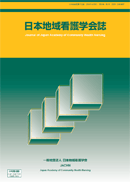Volume 21, Issue 3
Displaying 1-8 of 8 articles from this issue
- |<
- <
- 1
- >
- >|
Original Articles
-
2018 Volume 21 Issue 3 Pages 6-14
Published: 2018
Released on J-STAGE: December 20, 2019
Download PDF (1013K) -
2018 Volume 21 Issue 3 Pages 15-23
Published: 2018
Released on J-STAGE: December 20, 2019
Download PDF (1135K) -
2018 Volume 21 Issue 3 Pages 24-31
Published: 2018
Released on J-STAGE: December 20, 2019
Download PDF (1034K)
Research Report
-
2018 Volume 21 Issue 3 Pages 32-40
Published: 2018
Released on J-STAGE: December 20, 2019
Download PDF (1155K)
Informations
-
2018 Volume 21 Issue 3 Pages 41-48
Published: 2018
Released on J-STAGE: December 20, 2019
Download PDF (1008K) -
2018 Volume 21 Issue 3 Pages 49-55
Published: 2018
Released on J-STAGE: December 20, 2019
Download PDF (970K) -
2018 Volume 21 Issue 3 Pages 56-63
Published: 2018
Released on J-STAGE: December 20, 2019
Download PDF (977K) -
2018 Volume 21 Issue 3 Pages 64-70
Published: 2018
Released on J-STAGE: December 20, 2019
Download PDF (1023K)
- |<
- <
- 1
- >
- >|
